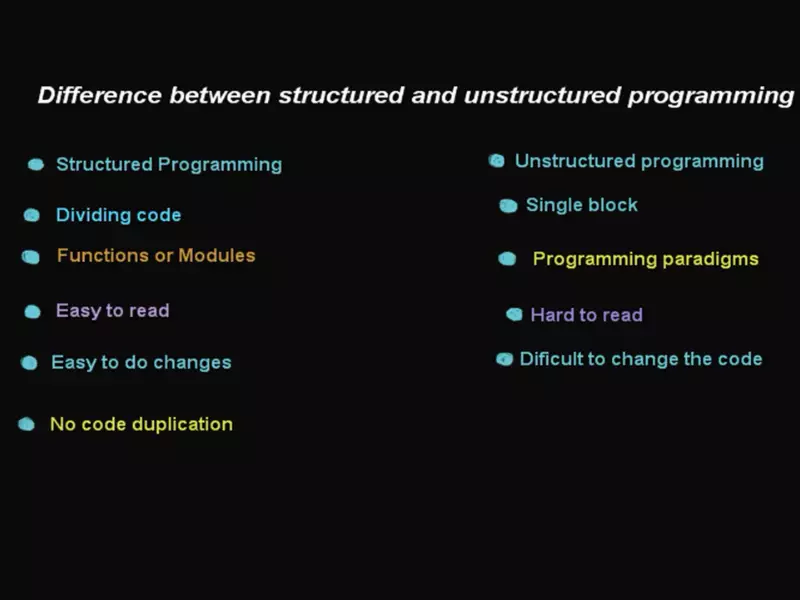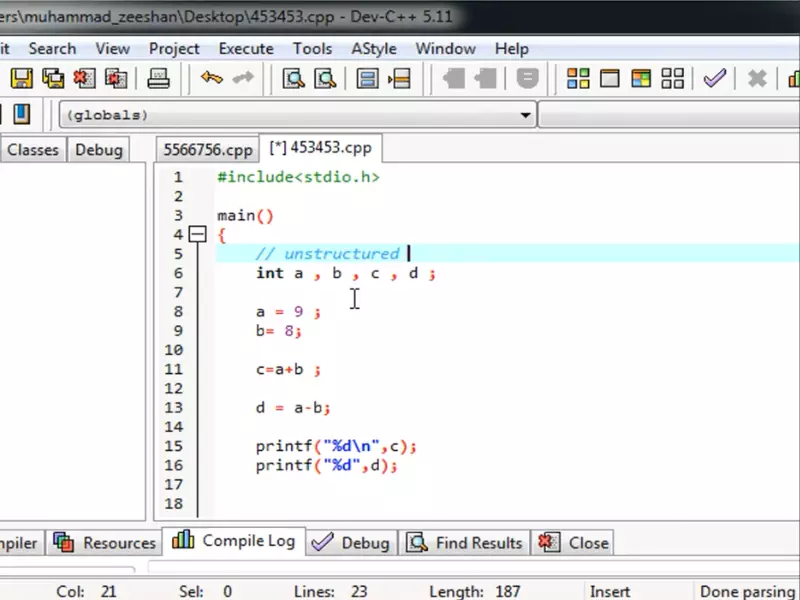In the diverse landscape of software development, the distinction between structured and unstructured programming represents a fundamental shift in how coders approach problem-solving and application design. This contrast not only highlights the evolution of programming paradigms but also underscores the significance of choosing the right approach to coding based on the project’s requirements, scalability, and complexity. Initially, programming was largely unstructured, a free-form method where code was written without strict guidelines or patterns, often leading to complex and hard-to-maintain software.
Structured programming, by comparison, is a methodology that emphasizes breaking down a program’s operation into smaller, manageable sections or blocks, using functions, loops, and conditional statements to control the flow of the program. This approach significantly enhances readability, maintainability, and debugging ease. In essence, the difference lies in the organization and control flow of code; structured programming uses a top-down approach with clear, predefined paths, whereas unstructured programming lacks such organization, potentially leading to “spaghetti code”.
The transition from unstructured to structured programming marked a pivotal moment in software development, setting the stage for the sophisticated, high-level programming languages and methodologies we use today. This evolution reflects the industry’s ongoing pursuit of more efficient, reliable, and manageable coding practices, illustrating the importance of structured programming principles in modern software development projects.

Unstructured Programming: Challenges Unveiled
Limitations with Scalability
In the realm of unstructured programming, scalability emerges as a significant challenge. Initially, when programs are small and manageable, this approach may seem sufficient. However, as software projects grow in complexity and size, the absence of a clear structure leads to complications. The primary issue with scalability in unstructured programming lies in its reliance on goto statements and the lack of modular code blocks. This results in a tangled web of code, often referred to as “spaghetti code,” where adding new features or scaling the application becomes a daunting task.
Maintenance and Debugging Issues
Another critical area where unstructured programming falls short is in maintenance and debugging. The core of the problem is the code’s complexity and lack of readability, which directly impacts a developer’s ability to understand, maintain, and debug the application effectively. Since the code does not follow a clear path or structure, identifying the root cause of issues or bugs can be time-consuming and frustrating. This not only increases the development time but also escalates the cost of maintenance.
Structured Programming: A Paradigm Shift
Definition and Features
Structured programming represents a paradigm shift designed to overcome the challenges posed by unstructured programming. It introduces a methodical approach to coding, emphasizing modularity, clarity, and simplification of control flow. This paradigm advocates for the use of subroutines, loops, and conditional statements instead of goto statements, promoting a top-down approach to program design.
Introduction to Structured Programming
Structured programming is not just a technique but a philosophy that underpins modern software development. It champions the idea that all programs can be constructed from a small set of control structures, which include sequence, selection, and iteration. This methodology facilitates the development of programs that are easier to understand, test, and maintain.
Key Characteristics and Principles
- Modularity: Breaking down a program into smaller, manageable, and reusable modules or functions.
- Local Variables: Encouraging the use of local variables within functions or blocks to avoid side effects.
- Sequential Control Flow: Ensuring that the program flows in a logical sequence, making it predictable and easier to follow.
Benefits
Improved Readability and Maintenance
Structured programming dramatically improves the readability and maintainability of code. By organizing code into functions or modules with a specific task, developers can easily understand the structure and logic of the program. This organization makes it straightforward to modify, extend, or maintain the software, thereby reducing the overall development cost.
Enhanced Debugging and Testing
Another significant advantage of structured programming is the ease of debugging and testing. Since the code follows a clear structure, identifying bugs and errors becomes much simpler. Moreover, modular code allows for unit testing of individual components, leading to more reliable and robust software.
Examples and Usage
Popular Languages Supporting Structured Programming
Languages like C, Java, and Python embody the principles of structured programming. They provide constructs such as loops, functions, and conditional statements that enable developers to write clear, structured code.
Application Areas
Structured programming finds its application across various domains, from system software to application software, including:
- Operating systems
- Database management systems
- Web applications
- Mobile applications
The use of structured programming in these areas not only streamlines development but also ensures that the software is scalable, maintainable, and efficient.

Transition from Unstructured to Structured Programming
Historical Context
The evolution from unstructured to structured programming is a cornerstone in the history of software development. In the early days of computing, programmers wrote code without much thought for structure or long-term maintainability. This changed in the 1960s and 1970s, as the software industry began to grapple with the “software crisis”, a term coined to describe the difficulties in writing and maintaining complex software systems.
Evolution of Programming Methodologies
The shift towards structured programming was largely influenced by the recognition of the need for better code organization and control flow. Pioneers like Edsger W. Dijkstra, Donald Knuth, and Tony Hoare played pivotal roles, advocating for programming practices that emphasized clarity, simplicity, and reliability.
Key Figures and Contributions
- Edsger W. Dijkstra introduced the concept of structured programming in his seminal paper “Go To Statement Considered Harmful”, sparking a revolution in how programmers thought about control flow.
- Donald Knuth, through his work “Structured Programming with go to Statements”, showed how complex algorithms could be broken down into manageable pieces without relying on goto statements.
- Tony Hoare contributed with the development of the Quicksort algorithm, demonstrating the power of divide-and-conquer strategies, a key principle of structured programming.
Impact on Software Development
Changes in Development Practices
The transition brought about a profound change in development practices. Programmers started organizing code into blocks and functions, making it easier to read, understand, and modify. This methodical approach allowed for more systematic testing and debugging, leading to more reliable software.
Long-term Benefits for the Industry
The long-term benefits of this paradigm shift have been immense. Structured programming laid the groundwork for modern software engineering practices, including object-oriented programming and functional programming. It also paved the way for the development of sophisticated software development tools and methodologies, such as integrated development environments (IDEs), version control systems, and agile methodologies.
Key Differences Between Paradigms
Code Organization
The primary distinction between unstructured and structured programming lies in code organization. Unstructured programming often resulted in spaghetti code, where the program’s flow was difficult to follow. In contrast, structured programming organizes code into clear, discrete blocks or functions, each with a specific task.
Control Flow
Control Flow Mechanisms
In unstructured programming, the control flow was managed using goto statements, leading to complex and tangled code. Structured programming, however, uses loops, conditional statements, and functions to manage control flow, making the code more predictable and easier to follow.
Debugging and Maintenance
The structured approach significantly simplifies debugging and maintenance. With code organized into modules or functions, finding and fixing bugs becomes much easier. Additionally, the modular nature of structured code means that parts of a program can be updated or replaced without affecting the rest of the system.
Scalability and Complexity
Managing scalability and complexity is another area where structured programming shines. As software projects grow, structured code can be more easily extended and scaled, thanks to its modular design. This contrasts sharply with unstructured programming, where adding new features can often lead to increased complexity and potential for errors.
Current Trends in Software Development
Modern Programming Practices
Structured programming has profoundly influenced modern programming practices. Today’s programming languages and development environments incorporate structured programming principles at their core, facilitating the creation of complex, high-quality software.
Influence on Modern Paradigms
The influence of structured programming extends beyond just the structure of code. It has shaped modern programming paradigms, including object-oriented programming (OOP) and functional programming (FP), which further refine the concepts of modularity and reusability.
Relevance in Today’s Development
Despite the dominance of structured and newer paradigms, unstructured programming concepts still find their place, particularly in understanding the evolution of programming practices and in educational contexts. Learning about unstructured programming can provide new developers with a deeper appreciation for the importance of code organization and control flow management.
Frequently Asked Questions
What is Structured Programming?
Structured programming is a programming paradigm aimed at improving the clarity, quality, and development time of a computer program by making extensive use of subroutines, block structures, for and while loops, and conditional if-then-else statements. This methodology facilitates more straightforward code that is easier to test and maintain.
How does Unstructured Programming differ?
Unstructured programming is characterized by a lack of predefined structure in code organization. Often seen in older programming languages like BASIC, it relies heavily on goto statements, leading to code that is generally harder to follow, debug, and maintain due to its “spaghetti” nature.
Why is Structured Programming preferred over Unstructured?
Structured programming is preferred because it significantly enhances code readability, maintainability, and scalability. By organizing code into blocks and using control structures, programmers can create more logical and straightforward code, making it easier to debug and update, thereby reducing the development time and cost.
Can Unstructured Programming still be useful?
Unstructured programming may hold historical significance and provide learning insights into the evolution of coding practices. However, its practical application in modern software development is limited due to its inefficiency, poor scalability, and the maintenance challenges it presents.
Conclusion
The journey from unstructured to structured programming encapsulates a crucial evolution in the field of software development. This transition not only streamlined the coding process but also set a foundation for the advanced programming languages and methodologies that define today’s software industry. By embracing structured programming, developers can tackle complex projects with greater efficiency, creating more reliable and maintainable software.
Moreover, understanding the differences between these two paradigms offers valuable insights into the importance of code organization and flow control in programming. As the field continues to evolve, the principles of structured programming remain at the heart of modern software development, ensuring that the creation of digital solutions is as logical, effective, and innovative as possible.
